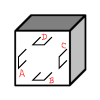Before I fry something in my car, I need some clarifications...
Intention:
I am hooking up some fog lights, 2 additional horns, and coolant fan to switches, seperating the switches from the actual powered accessories by means of relays. But i have an issue with lighted switches: read below
Question:
I previously had it hooked up as follows:
(LIGHTED SWITCH)
Battery to Power Prong of Switch
Accessery Positive to Accessory Prong of Switch
Ground Prong of Switch to suitable Chassis Ground
the light on the switches works
VIEW ATTACHMENT FOR RELAY DIAGRAM
A = From Battery Positive
B = To Accessory(+)
C = To Switching Means (to turn relay on)
D = Chassis Ground (for relay)
Now I hooked it up as follows:
1) Battery(+) to A
2) Battery(+) to C
3) Accessory(+) to B
4) Accessory(-) to Chassis Ground
5) Switch(+) to D
6) Switch(-) and Switch Accessory(+) to Chassis Ground
5 and 6 basicaly run off of prong D of the relay (which is the ground for the relay) and complete the ground circuit of the relay to turn on the relay.
The Accessory turned on in this manner works perfectly like it should, but the switch LIGHT does NOT come on.
The Light of the switch operates only when power comes through the switch(+) and out the switch(-), regardless if switch accessory(+) is attached to an accessory or not.
Right?
Well, in theory, the LIGHT of the switch should come on, regardless if the switch accessory(+) prong is the grounded with the switch(-) prong, because the switch is getting its power from the relay ... is that theory correct?
Im boggling my mind over this electric crap lmao. plz help clarify this issue.
Daniel
Intention:
I am hooking up some fog lights, 2 additional horns, and coolant fan to switches, seperating the switches from the actual powered accessories by means of relays. But i have an issue with lighted switches: read below
Question:
I previously had it hooked up as follows:
(LIGHTED SWITCH)
Battery to Power Prong of Switch
Accessery Positive to Accessory Prong of Switch
Ground Prong of Switch to suitable Chassis Ground
the light on the switches works
VIEW ATTACHMENT FOR RELAY DIAGRAM
A = From Battery Positive
B = To Accessory(+)
C = To Switching Means (to turn relay on)
D = Chassis Ground (for relay)
Now I hooked it up as follows:
1) Battery(+) to A
2) Battery(+) to C
3) Accessory(+) to B
4) Accessory(-) to Chassis Ground
5) Switch(+) to D
6) Switch(-) and Switch Accessory(+) to Chassis Ground
5 and 6 basicaly run off of prong D of the relay (which is the ground for the relay) and complete the ground circuit of the relay to turn on the relay.
The Accessory turned on in this manner works perfectly like it should, but the switch LIGHT does NOT come on.
The Light of the switch operates only when power comes through the switch(+) and out the switch(-), regardless if switch accessory(+) is attached to an accessory or not.
Right?
Well, in theory, the LIGHT of the switch should come on, regardless if the switch accessory(+) prong is the grounded with the switch(-) prong, because the switch is getting its power from the relay ... is that theory correct?
Im boggling my mind over this electric crap lmao. plz help clarify this issue.
Daniel



